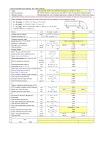Cooling towers are the heart of a building’s mechanical system. Without routine maintenance, they’re destined to experience problems that can lead to a complete shutdown of the entire building, making both the owner and tenants extremely unhappy.
Over time, a neglected cooling tower’s leaving water temperature will increase, raising energy costs by up to 6 percent for every 2°F increase. Properly maintained cooling towers and chillers keep condenser temperatures lower than un-maintained systems. This results in better energy efficiency, lower utility bill costs, and a more comfortable facility.
The following is a tasklist of the crucial elements for cooling tower maintenance. When done regularly and properly, you’ll be sure to keep to keep both the system and the building’s occupants humming.
- Control cooling tower fans based on temperature range and temperature approach. Ensure as low an approach as possible at the rated temperature.
- Control to the optimum temperature as determined from cooling tower and chiller performance data.
- Lower cooling water temperatures generally help reduce compressor power consumption.
- Use two-speed or variable speed drives for cooling tower fan control if the fans are few. Stage the cooling tower fans with on-off control if there are many.
- Turn off unnecessary cooling tower fans when loads are reduced.
- Cover hot water basins (to minimise algae growth that contributes to fouling.
- Balance flow to cooling tower hot water basins.
- Periodically clean plugged cooling tower distribution nozzles.
- Install new nozzles to obtain a more uniform water pattern.
- Replace splash bars with self-extinguishing PVC cellular film fill.
- On old counterflow cooling towers, replace old spray type nozzles with new square spray ABS practically non-clogging nozzles.
- Replace slat type drift eliminators with low pressure drop, self extinguishing, PVC cellular units.
- Follow manufacturer’s recommmended clearances around cooling towers and relocate or modify structures that interfere with the air intake or exhaust.
- Optimise cooling tower fan blade angle on a seasonal and/or load basis.
- Correct excessive and/or uneven fan blade tip clearance and poor fan balance.
- Use a velocity pressure recovery fan ring.
- Consider on-line water treatment.
- Restrict flows through large loads to design values.
- Shut off loads that are not in service.
- Take blow down water from return water header.
- Optimise blowdown flow rate.
- Send blowdown water to other uses or to the cheapest sewer to reduce effluent treament load.
- Install interlocks to prevent fan operation when there is no water flow.













0 Comments